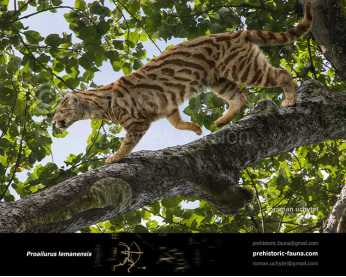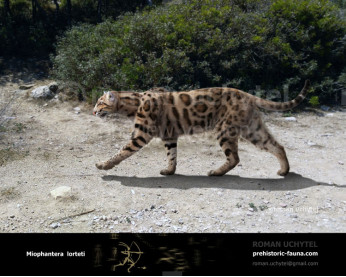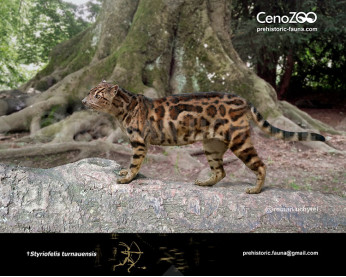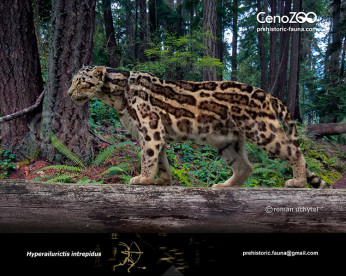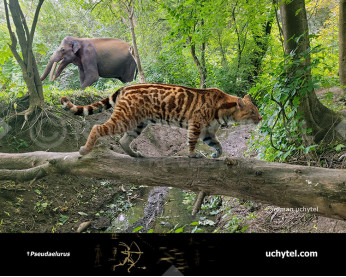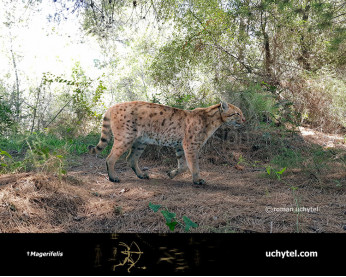Diamantofelis
314314Diamantofelis (†Diamantofelis (Morales et al., 1998))
Order: Carnivora
Suborder: Feliformia
Family: Felidae
Dimensions: height - 70 сm, weight - 45 kg
Temporal range: the Early Miocene of East Africa (17,5 - 17,2 million years ago)
Diamantofelis is the largest felid known from the Early Miocene of Africa. Its size has been described as slightly smaller than a cheetah,[ and as comparable to a small cougar.
Only fragmentary postcranial materials are known from this genus.
Except for its close relationship to Namafelis, the affinities of Diamantofelis are not well-understood. It is clearly not particularly closely related to Asilifelis or Katifelis, the other Early Miocene felids from Africa, which possessed comparatively advanced dental characteristics. Indeed, it has been suggested that Asilifelis originates from a different dispersal event into Africa altogether. Its features are of “Pseudaelurus-grade”, suggesting it is more basal than machairodontines and felines, and its dental features match those of European pseudaelurines. Similarities to the barbourofelid Afrosmilus, which was originally considered to have been a feline, have been noted since its original description. As such, possible barbourofelid affinities have been proposed. Nowadays, they are usually considered felids. Similarly, the assignment of the Afrosmilini to the barbourofelids has also been questioned, and it has been suggested that they were possibly felids closely related to Diamantofelis and Namafelis after all.
The habitat was likely a bushy, rather wooded savanna, with a gallery-forest along the river.
Diamantofelis shared its habitat with the stenoplesictid Africanictis meini, the large mustelid Namibictis senuti and the hyainailourid Buhakia hyaenoides. The largest predators of Arrisdrift were the bear-dogs Namibiocyon ginsburgi and Amphicyon giganteus, and the hyaenodont Hyainailouros sulzeri. Diamantofelis likely preyed on the smaller animals of this faunal assemblage, such as the macroscelidid Myohyrax, the springhare Megapedetes, the lagomorph Australagomys or various birds and rodents. Somewhat larger prey possibly included the small bovid Namacerus or young of the large hyrax Prohyrax. Other inhabitants include the small suids Namachoerus and Nguruwe, the tragulid Dorcatherium, the climacoceratid Orangemeryx, the diminutive aardvark Myorycteropus and the proboscidea Afromastodon and Prodeinotherium.
Diamantofelis (†Diamantofelis (Morales et al., 1998))
Order: Carnivora
Suborder: Feliformia
Family: Felidae
Dimensions: height - 70 сm, weight - 45 kg
Temporal range: the Early Miocene of East Africa (17,5 - 17,2 million years ago)
Diamantofelis is the largest felid known from the Early Miocene of Africa. Its size has been described as slightly smaller than a cheetah,[ and as comparable to a small cougar.
Only fragmentary postcranial materials are known from this genus.
Except for its close relationship to Namafelis, the affinities of Diamantofelis are not well-understood. It is clearly not particularly closely related to Asilifelis or Katifelis, the other Early Miocene felids from Africa, which possessed comparatively advanced dental characteristics. Indeed, it has been suggested that Asilifelis originates from a different dispersal event into Africa altogether. Its features are of “Pseudaelurus-grade”, suggesting it is more basal than machairodontines and felines, and its dental features match those of European pseudaelurines. Similarities to the barbourofelid Afrosmilus, which was originally considered to have been a feline, have been noted since its original description. As such, possible barbourofelid affinities have been proposed. Nowadays, they are usually considered felids. Similarly, the assignment of the Afrosmilini to the barbourofelids has also been questioned, and it has been suggested that they were possibly felids closely related to Diamantofelis and Namafelis after all.
The habitat was likely a bushy, rather wooded savanna, with a gallery-forest along the river.
Diamantofelis shared its habitat with the stenoplesictid Africanictis meini, the large mustelid Namibictis senuti and the hyainailourid Buhakia hyaenoides. The largest predators of Arrisdrift were the bear-dogs Namibiocyon ginsburgi and Amphicyon giganteus, and the hyaenodont Hyainailouros sulzeri. Diamantofelis likely preyed on the smaller animals of this faunal assemblage, such as the macroscelidid Myohyrax, the springhare Megapedetes, the lagomorph Australagomys or various birds and rodents. Somewhat larger prey possibly included the small bovid Namacerus or young of the large hyrax Prohyrax. Other inhabitants include the small suids Namachoerus and Nguruwe, the tragulid Dorcatherium, the climacoceratid Orangemeryx, the diminutive aardvark Myorycteropus and the proboscidea Afromastodon and Prodeinotherium.

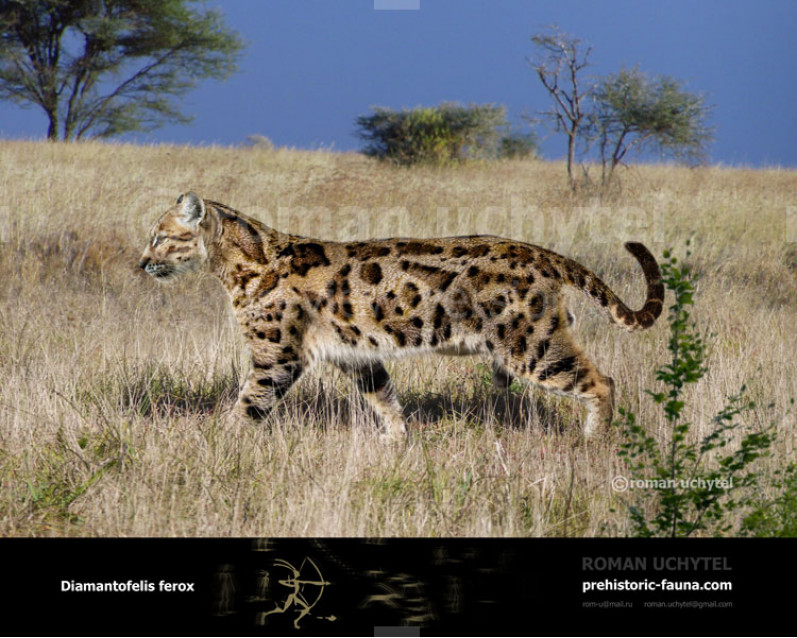
-797x638.jpg)

-70x56.jpg)
